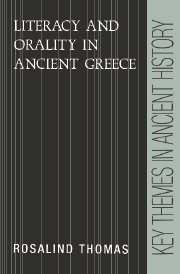Book contents
- Frontmatter
- Contents
- List of figures
- Acknowledgements
- List of abbreviations
- 1 Introduction
- 2 Literacy and orality
- 3 Oral poetry
- 4 The coming of the alphabet: literacy and oral communication in archaic Greece
- 5 Beyond the rationalist view of writing: between ‘literate’ and ‘oral’
- 6 Orality, performance, and memorial
- 7 Literacy and the state: the profusion of writing
- Epilogue: the Roman world
- Bibliographical essay
- Bibliography
- Index
4 - The coming of the alphabet: literacy and oral communication in archaic Greece
Published online by Cambridge University Press: 18 January 2010
- Frontmatter
- Contents
- List of figures
- Acknowledgements
- List of abbreviations
- 1 Introduction
- 2 Literacy and orality
- 3 Oral poetry
- 4 The coming of the alphabet: literacy and oral communication in archaic Greece
- 5 Beyond the rationalist view of writing: between ‘literate’ and ‘oral’
- 6 Orality, performance, and memorial
- 7 Literacy and the state: the profusion of writing
- Epilogue: the Roman world
- Bibliographical essay
- Bibliography
- Index
Summary
In early Greece from the eighth century BC we may observe the gradual development and extension of the written word in a society which, as everyone agrees, still performed almost entirely without writing. Much attention has been devoted to the very earliest uses of this alphabet, less to its later application. It has also been tempting to concentrate on the more intelligible examples of early writing, especially those which foreshadow later usage, and ignore the less straightforward — or even quite incomprehensible — pieces. Yet the many obscure graffiti are just as important a part of the impact of the alphabet, and I shall stress them in this chapter precisely because no picture of archaic writing can be complete without them. Nor can we discern the impact of writing at all adequately without assessing the nature of the non-written background. Very few discussions really attempt this (and since our evidence is slanted overwhelmingly towards what was written, it is very hard). The debate is often dominated by the controversy over whether the alphabet was invented to record poetry, which disregards much of the evidence. But we would also like to ask more generally whether — or how far — early Greek writing simply represented speech.
- Type
- Chapter
- Information
- Literacy and Orality in Ancient Greece , pp. 52 - 73Publisher: Cambridge University PressPrint publication year: 1992

